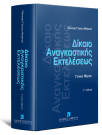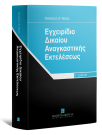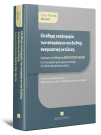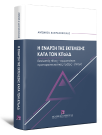P. Yessiou-Faltsi, Civil Procedure in Hellas, 2nd ed., 2020

This second edition of the book “Civil Procedure in Hellas” (1995) presents the major changes of the Code of Civil Procedure of 1968/1971, imposed in the midst of the country’s economic crisis by Laws 4335/2015, 4475/2017, and 4512/2018, as one of the measures to treat some of its side-effects by achieving simplification and, thus, acceleration of civil trials by all means.
Although the main institutions and concepts of the Code have remained intact, there has been a radical revision regarding the mode of conducting the first instance proceeding, as well as the means of evidence to be produced. Ordinary first instance, as well as, in principle, second instance proceedings, are now purely written, while testimony may be allowed only in exceptional cases. The ability of the parties to conduct several procedural acts through electronic means is also an important novelty brought about by Law 4335/2015, which, however, to this day, due to technical shortcomings, has not been yet implemented on a general scale. In addition, the enforcement proceedings for money claims have been almost totally revised. Most of the enforcement acts must be now conducted through electronic channels, since February 2018 including the auction. Beyond the simplification of the revised enforcement proceeding, the possibilities of the debtors to oppose execution have been considerably eliminated.
This book contains an extended version of the second edition of the 2019 monograph, originally published in the International Encyclopaedia of Laws/Civil Procedure, Wolters Kluwer, 2019. Accordingly, the present publication, as also its first edition, again follows the detailed plan elaborated by the editors of the series. In addition, an effort has been undertaken to enrich the original monograph with some more specific aspects of Greek Procedural Law, including references to recent standard Greek legal scholarship, to several specialized monographs related to the imposed modifications and to some important recent court decisions.
To this day, the book “Civil Procedure in Hellas” still remains the sole comprehensive monograph of this length to treat the entire Greek Procedural Law in English or in a language other than Greek. This second edition, encompassing the radical changes brought to the structure of the Code of Civil Procedure 1968/1971, has been elaborated with the hope that legal professionals and legal scholars will consult it when needed with the same level of interest as the first edition.
Edition info
Table of contents +-
Preface to the Second Edition
Preface to the First Edition
Abbreviations
GENERAL INTRODUCTION
Chapter 1. General Background
§1. Political System
§2. Legal System
I. Historical Evolution
II. Classification
III. Legal Sources
IV. Distinctions and Basic Elements
Chapter 2. Delimitation of the Subject Matter
§1. Definition of the Term «Civil Procedure»
§2. Distinction from other Types of Procedure - Separate Systems of Courts and Rules of Procedure
Chapter 3. Sources of Civil Procedural Law
§1. A Brief Historical Perspective
I. General Remarks
II. Ancient Greek Law
III. Period of the Turkish Domination
IV. Period of the War of Independence
V. Period of the Codes of
§2. Contemporary Sources of Civil Procedural Law
I. The Constitution of
II. The Code of Civil Procedure of 1967/1971 - Subsequent Modifications
III. The Code on the Organization of the Courts of
IV. Special Laws
V. International Conventions
VI. Customary Law
VII. Judicial Precedents
VII. Legal Doctrine
Chapter 4. General Features of the Administration of Justice in Civil Matters
§1. Characteristics of the Procedure
I. General Remarks
II. The Principle of Free Disposition of the Parties
III. The Principle of Party Presentation
IV. The Principle of Parties’ Motion
V. The Principle of Concentration
VI. Oral and Written Procedure
VII. Role of the Judge
§2. Fundamental Guarantees
I. General Remarks - The Convention of Rome for the Protection of Human Rights
II. Establishment of Courts by Law
III. Independence and Impartiality of the Judiciary
IV. Review of Unconstitutional Ordinary Legislation
V. Access to Justice
VI. Right of Defence
VII. Equality of the Parties
VIII. Publicity
IX. Reasoning of Judicial Decisions
Selected Bibliography in Greek
I. Books
1. Under the Previous Code of Civil Procedure (1835-1968)
a. General Manuals and Treatises
b. Commentaries by Article
c. Special Manuals and Treatises
d. Collections of Studies Related to Civil Procedure
e. Monographs
2. Under the Code of Civil Procedure of 1967/1971
a. General Manuals and Treatises
b. Commentaries by Article
c. Special Manuals and Treatises
d. Commentaries of Special Parts of the Code
e. Collections of Studies Related to Civil Procedure
f. Monographs
II. Materials for the Code of Civil Procedure of
III. Periodicals
Bibliography in Languages Other than the Greek
I. Books or General Works
II. Monographs related to Civil Procedure
III. Special Essays, Articles, Reports
IV. Translations of Legislative Texts
IV. Periodicals
PART I. JUDICIAL ORGANIZATION
Chapter l. The Courts and Their Members
§1. Courts
I. Structure of the Court System
II. Administration of the Courts
1. Historical Overview
2. Separation of the Three Jurisdictions
3. Ordinary Courts of First Instance
4. The Special Court of «Moufti»
5. The Courts of Appeal
6. The Court of Areios Pagos
7. The Special Highest Court
8. The Limited Role of Lay Participants
III. The Role of Public Prosecutors in Civil Proceedings
IV. Appointment of Judges and of Public Prosecutors
§2. Members of the Judiciary
I. Incompatibilities
II. End of Functions
III. Discipline
1. The Historical Background
2. Disciplinary Responsibility under the Constitution of
Chapter 2. The Bar
§1. Exercise of the Legal Profession
I. Conditions for Admission
II. Rights and Duties
III. Discipline
§2. Organisations of Lawyers
Chapter 3. The Bailiffs
§1. Exercise of the Profession
§2. Public Institutions of Bailiffs
PART II. JURISDICTION
Chapter 1. Internal Jurisdiction
§1. Jurisdiction of Civil Courts
I. Definition of Jurisdiction - Distinction of Jurisdictional Branches
II. Criteria for Distinguishing Jurisdiction of Civil and of Administrative Courts
III. Voluntary Jurisdiction of Civil Courts
IV. Lack of Jurisdiction of Civil Courts
§2. Subject Matter Competence of Civil Courts
I. Factors to be Taken into Account
1. Definition of Subject Matter Competence
2. Role of the Value of the Claim
3. Role of the Nature of the Claim
II. Determination of the Value of the Claim - Main Claims and Ancillary Claims
III. Overview of the Subject Matter Competence of the Different Courts
1. Subject Matter Competence of the Justices of the Peace
2. Subject Matter Competence of the One-Member District Courts
3. Subject Matter Competence of the Three-Member District Courts
4. Subject Matter Competence of the Courts of Appeal
5. Subject Matter Competence of Areios Pagos
§3. Territorial Competence
I. Factors to Be Taken into Account
1. Definition and Distinctions of Territorial Competence
2. Relevant Connecting Factors and the Conflicting Interests Served
II. Overview of the Different Rules
1. General Territorial Competence
a. Domicile as a Principal Connecting Factor
b. Rules Founding General Jurisdiction
c. Actions Against the State
d. Actions Against Legal Entities
2. Jurisdictions Concurrent to the General Territorial Competence
a. The Forum Involving Juridical Acts
b. The Forum for Tort Disputes
c. The Forum Related to the Management of Property Other than Under a Court Order
d. The Forum Involving the Joinder of Defendants
e. The Forum Related to Actions Involving Multiple Immovables
f. The Forum for Matrimonial Disputes
g. The Forum based on Property
3. Exclusive Jurisdictions
a. The Exclusive Forum for Company Disputes
b. The Exclusive Forum Related to the Management of Property When This Is Based on a Judicial Order
c. The Exclusive Forum in Actions Involving Real Rights on Immovable Property
d. The Exclusive Forum Concerning Succession
e. The Exclusive Forum for Related Claims
f. The Exclusive Forum for Cross Actions
g. The Exclusive Forum for Litigation Involving Enforcement Proceedings
III. Prorogation of Territorial Competence
1. General Remarks
2. Explicit Agreements
3. Tacit Agreements
§4. Resolution of Jurisdiction Conflicts
I. Affirmative Conflicts
II. Negative Conflicts
III. Effects of the Ruling
IV. Relevant Moment for the Existence of Jurisdiction
§5. Review of Subject Matter and of Territorial Competence
I. Relevant Moment for the Existence of Facts Basing Competence
II. Lack of Competence
Chapter 2. International Jurisdiction
§1. Rules Applicable in the Absence of a Treaty
I. The Historical Background
1. Nationality as a Main Connecting Factor Under the Code of Civil Procedure of 1835
2. Modification of the Critical Factor of Nationality in
II. International Jurisdiction According to the Present Code of Civil Procedure
1. Territorial Competence as a Main Connecting Factor
2. Role of Nationality in Exceptional Cases
3. International Jurisdiction Based on Public Policy
4. International Jurisdiction with Regard to Matters of Voluntary Jurisdiction
III. The Impact of Private Agreements on International Jurisdiction
1. Prorogation of the International Jurisdiction of Greek Courts
a. The Permissibility of Private Agreements
b. Explicit Agreements
c. Tacit Agreements
2. Derogation of Greek Adjudicatory Power
IV. Review of International Jurisdiction
§2. International Treaties
I. Multilateral Conventions
1. The European Community Convention on Jurisdiction and the Enforcement of Judgements in Civil and Commercial Matters
2. Other Multilateral Conventions
3. Conventions Related to Extraterritoriality
II. Bilateral Conventions
1. The Irrelevancy of Assimilation Clauses in Bilateral Conventions
2. Specific Rules in Bilateral Conventions for Jurisdiction in Succession Matters
3. Specific Rules for Maintenance Claims and Matters Involving Personal Status
PART III. ACTIONS AND CLAIMS
Chapter 1. Actions
§1. Definitions - Types of Actions - Joinder
I. Definitions
1. The Action as a Procedural Act
2. The Action as a Procedural Document
a. Contents of the Complaint
b. Sanctions
II. Types of Actions
1. Criteria of Classification
2. Actions for Specific Performance
3. Declaratory Actions
4. Constitutive Actions
III. Joinder
1. Joinder of Parties
a. Permissive Joinder
b. Necessary Joinder
2. Joinder of Claims
a. General Features
b. Subsidiary Joinder
§2. Admissibility
I. The Function of Procedural Prerequisites
II. Capacity to Be a Party
III. Capacity to Conduct Proceedings in One’s Own Name
IV. Representation by Attorney
V. Standing to Sue
VI. Legal Interest
§3. Prohibition of Abuse of Procedural Rights - Vexatious Litigation
Chapter 2. The Defendant’s Answer and Defences
§1. General Aspects
§2. Defendant’s Answer on the Action
§3. Exceptions
I. Definition
II. Distinctions
III. Rules Governing Exceptions
§4. Cross Actions
Chapter 3. Sanctions on Procedural Irregularities
§1. Aspects of Procedural Irregularities
I. Definitions
II. The Non-Existent Judicial Decisions
III. Procedural Nullities
1. Distinction Among Substantial and Procedural Nullities
2. Types and Conditions of Procedural Nullities
§2. Time Limitations
PART IV. PROCEEDINGS
Chapter 1. Pre-trial Proceedings
§1. Provisional Remedies
§2. Pre-trial Settlements of the Parties
I. Extrajudicial Settlements
ΙΙ. Pre-trial Conciliations
IΙI. Mandatory or Optional Attempt at Conciliation?
IV. Practical Relevance
§3. Preliminary Administrative Procedure in Real Actions Against the State
Chapter 2. Proceedings in First Instance
§1. Adversary Proceedings
I. Ordinary Proceedings
1. Introduction of the Action
a. Method of Initiating the Action
b. Modes of Service of the Complaint
c. Time limits
2. Effects of the Initiation of an Action
a. Procedural Effects - Lis Pendens
b. Substantial Effects
3. Progress of Proceedings
a. Preparatory Measures - Written Pleadings - Production of Documents
b. The Trial
4. Third Party Proceedings
a. Basic Distinctions
b. Principal Intervention.
c. Accessory Interventions
d. Impleader
e. Third Party Notice
5. Judgement
a. Deliberation
b. Different Sorts of Judgement
c. Formal Aspects
d. Notice and Service
e. Effects of Judgements - Res Judicata
f. Distinctions of Res Judicata
g. The Function of Res Judicata
h. Object and Objective Limits of Res Judicata
j. Subjective Limits of Res Judicata
k. Collateral Estoppel
l. Reformation Action
m. Interpretation and Rectification of Judgements
II. Proceedings for Provisional Remedies
1. Introductory Remarks
2. General Prerequisites
a. Substantive Conditions
b. Procedural Prerequisites - Subject Matter and Territorial Competence
c. International Jurisdiction
3. Procedure for Granting Provisional Remedies
a. Commencement of Proceedings
b. Main Hearing
c. Decision on the Application
d. The Provisional Res Judicata
e. Non-Availability of Methods of Review
f. Enforcement
4. Revocation of Provisional Remedies
a. Mandatory Revocation
b. Revocation at the Discretionary Power of the Judge
5. Provisional Orders
§2. Default Proceedings
I. General Conditions
II. The Defendant’s and the Plaintiff’s Default at the First Hearing
III. Absence of the Parties at Later Hearings
§3. Ex parte Proceedings
I. Voluntary Jurisdiction
II. Orders of Payment and Provisional Remedies
Chapter 3. Review Proceedings
§1. Introductory Remarks
I. Definition and Distinctions
II. General Rules
III. Initiation
IV. Admissibility
§2. Opposition Against Default
I. General Aspects - The Abandonment of the Institution of «Unjustified» Opposition
II. Requirements and Effects
§3. Appeal
I. General Aspects
II. Conditions to Admissibility
1. Appealability
2. Appeal Period
III. The Grounds of Appeal
IV. Effects
V. Proceeding
§4. Cassation
I. General Aspects
II. Conditions
1. Decisions which are Subject to a Cassation
2. Time Period
3. Grounds for Cassation
III. Proceeding
IV. Cassation in «the Interest of the Law»
§5. Reopening of Judgements
I. General Aspects
II. Conditions
1. Decisions which are Subject to a Reopening
2. Time Period
3. Grounds for Reopening
III. Proceeding
§6. General Opposition and Third Party Opposition
I. General Opposition
II. Third Party Opposition (Tierce - Opposition)
1. General Features
2. Requirements
3. Proceeding
4. Effects
Chapter 4. Incidents
§1. Decision on Incidental Matters
I. Definition and Distinctions - Procedural Treatment
II. Incidental Actions
§2. Withdrawal and Discontinuance of Action
I. The Structure of the Code with Regard to the Subject
1. Possibilities on Terminating the Proceedings on Parties’ Volition
2. Revocation of Other Procedural Acts
II. Abandonment or Withdrawal of Action
1. Substantial and Formal Requirements
a. Withdrawal of an Action by the Plaintiff not Including Abandonment of the Substantial Claim
b. Abandonment of an Action by the Plaintiff Also Including the Substantial Claim
c. The Necessity for Formality in the Termination of Proceedings Through a Plaintiff’s Act
2. Consequences
a. Withdrawal of an Action Not Including the Substantial Claim
b. Abandonment of an Action Also Including the Substantial Claim
III. Admission
IV. Conciliation
1. Distinctions
2. Legal Nature
3. Formal and Substantial Requirements
4. Consequences
§3. Challenge of Judges
I. Disqualification of a Judge in General
II. Disqualification of a Judge on the Challenge of a Party
Chapter 5. Legal Aid
Chapter 6. Legal Costs
I. General Aspects
II. Applications of and Deviations from the «Defeat Principle»
PART V. EVIDENCE
Chapter 1. Burden of Proof
§1. The Allocation of the Burden of Proof
I. General Aspects
1. The Subject Matter of Evidentiary Proceedings
2. «Subjective» and «Objective» Burden of Proof
3. Significance of the Rules Governing the Burden of Proof
4. The Burden of Alleging the Relevant Facts
II. Rules Regarding the Allocation of the Burden of Proof
1. The General Rule
2. Doctrinal Distinctions of Substantive Rules with Regard to the Allocation of the Burden of Proof
3. Difficulties in the Application of the General Principles
III. Characterization of Rules Related to the Allocation of the Burden of Proof
IV. The Right to Counterproof
§2. Relationship Between Legal Presumptions and the Burden of Proof
Chapter 2. Admissibility of Evidence
§1. Introductory Remarks
I. General Features of the Law of Evidence
II. Types of Evidence
1. Rigid, Free and «Partly Free» Evidence
2. Direct and Indirect Evidence
3. «Preservative» Evidence
III. Free Evaluation of Evidence
IV. Degree of Persuation
§2. The Means of Proof in Particular
I. General Aspects
1. Enumeration in Article
2. Illegally Obtained Evidence
II. Confession
1. Definition and Distinctions
2. Prerequisites
3. Probative Effect of a Confession
4. Revocation of Confessions
III. Tangible or Direct Evidence
1. Definition
2. Obligation to Cooperate
3. Probative Effect of Tangible Evidence
IV. Expert Reports
1. Definition and Distinctions
2. Appointment of Experts - Extent of the Discretionary Power of the Judge
3. Probative Weight of Expert Reports
4. Technical Consultants
5. Extrajudicial Private Opinions
V. Testimony
1. Definition
2. Statutory Restrictions of Testimony
3. Competence to Give Evidence
4. Obligation to Give Evidence
5. Probative Weight of Testimony
VI. Examination of the Parties
1. General Aspects
2. The Subsidiary Character of the Examination of the Parties - The Amendment of 1984
3. Distinction from Other Interrogatories of the Parties and from Testimony
4. Confession of the Parties During an Examination
5. Probative Weight of the Examination of the Parties
VII. Party Oath
1. General Remarks
2. Party Oath Taken Upon the Challenge of the Adversary
a. Requirements
b. Form of the Party Oath
c. Subsidiarity of Party Oath
d. Possibilities Related to the Challenge
e. Probative Effects of the Party Oath
3. Judicial Oaths
VIII. Documentary Evidence
1. Definitions and Distinctions
2. Authenticity of Documents
a. Presumption of Authenticity of Public Acts
b. Authenticity of Private Writings
3. Persons Against Whom a Document can Produce Evidence
4. Certainty of Date - Authentication of Private Writings
5. Probative Effect of Documentary Evidence
a. Public Documents
b. Private Writings
c. Foreign Public Acts
6. Mechanical Reproductions
7. Bookkeeping Records of Enterprises or of Other Professionals
IX. Presumptions as Self-Standing Means of Evidence
1. The Historical Background
2. The Dual Meaning of the Term Presumption
3. Admissibility of Presumptions
4. Probative Effect
X. Sworn Attestations
Chapter 3. Administration of Evidence
§1. General Aspects
I. The Current Distinction Between Two Types of Evidentiary Proceedings
II. The Historical Background
1. The Code of Civil Procedure of
2. The Code of Civil Procedure of
3. The Revision of
4. The Revision of
5. The Revision of
6. The Revision of 1994 concerning the Evidentiary Proceedings before the Three-member District Courts
7. The Revision of
§2. Evidenciary Proceedings after the 2015 Amendment
§3. Forced production of documents
PART VI. PARTICULAR PROCEEDINGS
Chapter 1. General Aspects
Chapter 2. The Main Characteristics of Each Particular Proceeding
I. The Proceeding for Family Disputes
II. The Proceeding for Orders of Payment
III. The Proceeding for Certain Categories of Monay Claims
IV. Special Rules for Certain Types of Disputes - Small Claims
PART VII. PRELIMINARY SEIZURE AND ENFORCEMENT
OF JUDGEMENTS
Chapter 1. Preliminary Seizure and Other Conservatory Measures
§1. Definitions, Proceedings, Effects
I. General Remarks
II. Judicial Security
1. Definition
2. Proceeding
3. Effects
III. Prenotice of Mortgage
1. Definition and Requirements
2. Proceeding
3. Effects
IV. Conservatory Attachment
1. Definition and Requirements
2. Proceeding
3. Effects
V. Custody
1. Definition and Proceeding
2. Effects
VI. Sealing, Unsealing, Inventory and Public Deposit of Property
§2. Judicial Review
Chapter 2. Enforcement of Judgements
§1. Enforcement of Domestic Judgements
I. Introductory Remarks
1. Methods of Enforcement in the Greek Law of Execution
2. Specific Performance
3. Means of Enforcement of Money Claims: Attachment, Compulsive Administration of Property, Imprisonment
4. “Oath of Manifestation”
II. General Features of the Enforcement Proceedings
1. The Principle of the Party’s Initiative and its Limitations
a. The Meaning of this Principle
b. The Limitations - Lapse of Attachment
2. Collective Character of Enforcement
a. Announcement of Creditors
b. Substitution of the Petitioning Creditor
c. Satisfaction of Creditors
3. Main Organs of Execution
4. Attachability and its Limitations
III. The Executory Title as a General Prerequisite of Execution
1. General Remarks
2. Judicial Decisions
a. Kind of Decision
b. «Final» Judgements Which are a Formal Res Judicata
3. Provisionally Enforceable Judgements
a. General Remarks
b. Requirements
c. Specific Prerequisites
d. Kinds of Provisional Execution
e. Exclusion of Provisional Execution
f. Suspension of Provisional Execution
4. Arbitral Awards
5. Orders of Payment
6. Foreign Judgements
7. Foreign Arbitral Awards
8. Provisional Remedies
9. Notarial Documents
10. Awards Issued by Administrative Authorities for the Collection of Public Revenues
11. Orders for the Return to the Lessor of a Leased Immovable
IV. The Executory Formula
V. Other Prerequisites to Execution
1. Prerequisites Involving the Enforced Claim
2. Prerequisites Involving Persons Entitled to or Subject to Enforcement
3. Service of the Copy of the Instrument to be Enforced
VI. Initiation of Main Enforcement Proceedings
VII. Proceedings in Specific Enforcement
1. Obligations to Deliver a Particular Movable Thing
2. Obligations to Deliver Fungible Goods Described Only by Class, as Well as No-Name Bonds
3. Obligations to Deliver Specific Immovable Property
4. Enforcement of Executory Titles Ordering the Performance of a Specific Act
a. Obligations to Perform a Specific Fungible Act
b. Obligations to Perform a Specific Infungible Act
5. Obligations not to Perform or not to Oppose a Specific Act
6. Execution of Judgements Ordering the Declaration of Will
VII. Proceedings in Enforcement for Money Claims
1. General Remarks
2. The Various Types of Attachment
3. Attachment of Movables in the Possession of the Debtor
a. Property Subject to Attachment
b. Property Exempt From Attachment
c. The Procedure
d. Effects.
4. Garnishee Proceedings
a. Property Subject to and Exempt from Garnishee Proceedings
b. Procedure
c. Legal Effects
d. The Affirmative or Negative Declaration of the Third Party Regarding his Relation to the Attached Claim
e. The Final Phase of Garnishment
5. Attachment of Immovable Property
a. Property Subject to Attachment
b. The Procedure
c. Legal Effects
6. Attachment of Special Assets
7. The Public Sale
a. The Basic Preparatory Step
b. The Main Procedure
c. Suspension of the Electronic Auction Involving Immovables
d. The Termination of the Electronic Auction
8. Distribution of Sale Proceeds
a. The Principle of Proportional Distribution
b. Distribution where the Sale Proceeds Suffice to Satisfy all Creditors
c. Distribution where the Sale Proceeds do not Suffice to Satisfy all Creditors - General and Special Priorities
IX. Judicial Review
1. The Court Is Not an Organ of Execution
2. Opposition to Enforcement
a. General Remarks
b. Other Types of Opposition
c. Subject Matter Competence
d. Territorial Competence
e. Grounds of Opposition
f. Time Limitations
g. Rules of Procedure
3. Third Party Opposition
a. Particular Features
b. Grounds of a Third Party Opposition
c. Subject Matter and Territorial Competence
d. The Compulsory Parties
e. Time Limitations
4. Suspension of Enforcement
a. Conditions
b. Procedure - Provisional Order
c. Effects
§2. Recognition and Enforcement of Foreign Judgements
I. Rules Applicable in the Absence of a Treaty
1. General Remarks
a. The Doctrinal Foundation of the Recognition and Enforcement of Foreign Judgements
b. Distinction Between Recognition and Enforcement
c. Characterization of the Foreign Judgement
2. The Historical Background - Distinction Between Greek Nationals and Aliens
3. The Basic Provisions of the Present Code of Civil Procedure
4. The Prerequisites to Recognition
a. The Res Judicata Effect of the Foreign Judgement
b. The International Jurisdiction of the Foreign Court
c. Protection of the Right of Defence
d. Inconsistent Decisions
e. Violation of Public Policy
f. No Re-examination of the Merits
g. No Reciprocity
h. No Examination of the Applicable Law
5. Enforcement of a Foreign Judgement
a. Need of a Domestic Exequatur
b. Prerequisites
c. The Enforceability of the Foreign Judgement in Particular
d. The Exequatur Proceeding
6. Enforcement of Other Executory Instruments
7. The Specific Proceeding for the Recognition of Decisions Involving Personal Status
8. Recognition of the Effects of Foreign Decisions of Voluntary Jurisdiction
II. International Treaties
1. Multilateral Conventions
a. The European Community Convention and the Subsequent European Regulations
b. Other Multilateral Conventions
2. Bilateral Conventions
3. Relationship Between the Code of Civil Procedure and the International Conventions
PART VIII. ARBITRATION
Chapter 1. Domestic Arbitration
§1. General Aspects
I. Historical Background
II. Current Relevance
III. Types of Arbitration - Constitutionality
IV. Institutional Arbitration
§2. The Rules of the Code of Civil Procedure
I. Arbitrable Disputes
II. The Arbitration Agreement
III. The Arbitrators
IV. Procedure Before Arbitrators - Scope of the Arbitrators’ Authority
V. The Award
VI. Setting Aside of the Award
Chapter 2. Foreign Arbitral Awards
I. Characterization of an Award as Foreign
II. Recognition of Foreign Arbitral Awards Under the Code of Civil Procedure
III. Enforcement of Foreign Arbitral Awards
IV. International Treaties
1. Multilateral Conventions
2. Bilateral Conventions
3. Relationship to Domestic Law
PART IX. MEDIATION
Chapter 1. Legislation/Definitions
Chapter 2. Rights that can be Subject to Mediation - Mediation Agreement - Mediation Procedure - Settlement Agreement
Chapter 3. Judicial Mediation
Chapter 4. Practical Relevance of Mediation
Index





















